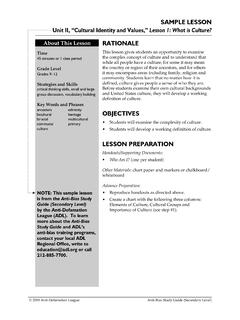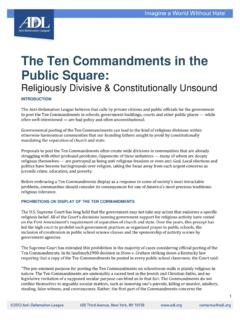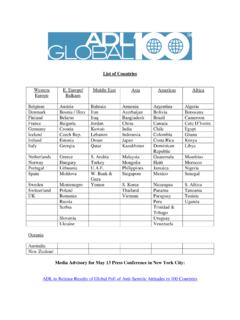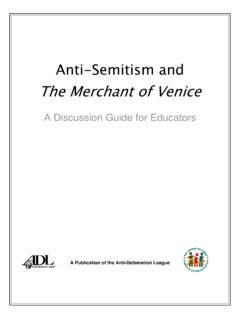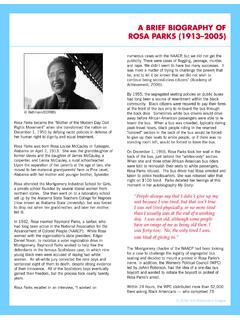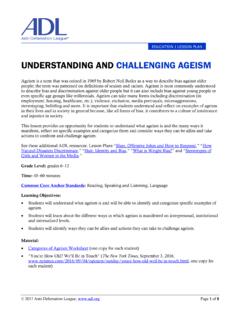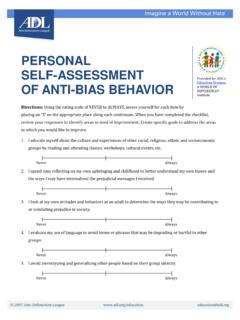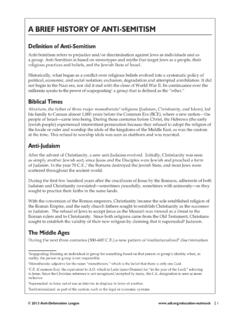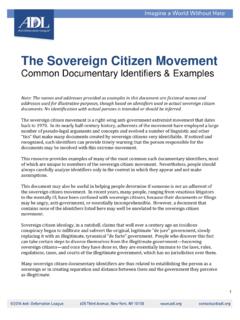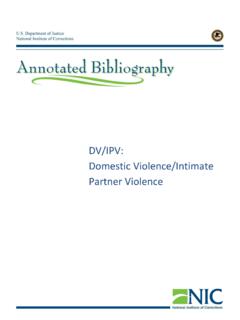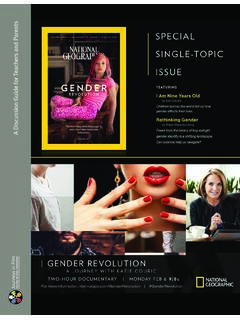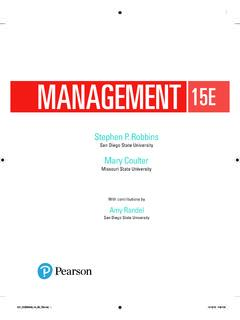Transcription of THE FIRST AMENDMENT AND OUR FREEDOMS
1 THE CURRENT EVENTS. CLASSROOM. THE FIRST AMENDMENT AND OUR. FREEDOMS . Congress shall make no law respecting an establishment of religion, or prohibiting the free exercise thereof; or abridging the freedom of speech, or of the press; or the right of the people peaceably to assemble, and to petition the Government for a redress of grievances. The 45 words that make up the FIRST AMENDMENT haven't changed since they were adopted by the United States as part of the Bill of rights on December 15, 1791. For over 200 years, the FIRST AMENDMENT has been the cornerstone of freedom in the United States. Commonly referred to as the five FREEDOMS , the FIRST AMENDMENT has helped people in the exercise their rights to work for a more free and just society and impacts every aspect of our lives. The FIRST AMENDMENT guarantees FREEDOMS of speech, religion, the press, association and petition, and was a radical and revolutionary departure from a world in which state-imposed religious persecution, censorship and oppression was the norm.
2 As those living in the , we should be proud to have the liberty to exercise these rights , which are not guaranteed in many other countries. The Constitution set the guiding principles for our nation, and over 200 years later, the FREEDOMS contained in the Bill of rights distinguish us from other nations. Every important struggle for social justice has involved the FIRST AMENDMENT in one way or another;. abolitionism, suffrage, civil rights movement, women's movement, child labor movement, environmentalist movement, lgbt movement and those working for disability rights have all relied on the FIRST AMENDMENT . A Knight Foundation survey about student and teacher perspectives on the FIRST AMENDMENT , Future of the FIRST AMENDMENT : 2014 Survey of High School Students and Teachers, had a number of interesting findings: (1) for the FIRST time in the 10-year period of the study, high school students had a greater appreciation for the FIRST AMENDMENT than do adults; (2) FIRST AMENDMENT support is highest among students who report more frequently consuming news and information through digital media and those who are taking a class dealing with the FIRST AMENDMENT ; (3) students are far less concerned than adults about the privacy of the personal information they give out on the Internet and (4) a majority of students said that freedom of Speech was the most important of the FREEDOMS to them.
3 In this lesson, students will have the opportunity to reflect on what freedom means to them, understand the FIRST AMENDMENT FREEDOMS and their complexities, explore cases brought before the courts that are impacted by the FIRST AMENDMENT FREEDOMS , and create a project that reflects how the FIRST AMENDMENT impacts their daily lives. 2016 Anti-Defamation League, Page 1 of 22. The Current Events Classroom See these additional ADL resources: Religious freedom Publications & Resources, Primer on the FIRST AMENDMENT & Religious freedom , Religion in the Public Schools, The December Dilemma: Navigating Religious Holidays in the Public School Webinar and Current Events Classroom Addressing Hate Online: Countering Cyberhate with Counterspeech.. Grade Level: grades 9 12. Time: Two 45-minute class sessions Common Core Anchor Standards: Reading, Writing, Speaking and Listening, Language Learning Objectives: Students will reflect on what freedom means to them and will be able to define freedom .
4 Students will understand the five FREEDOMS associated with the FIRST AMENDMENT . Students will explore a court case involving one of the FREEDOMS associated with the FIRST AMENDMENT . Students will express how the FIRST AMENDMENT impacts their daily lives through writing, artwork or other project of their choice. Compelling question : What are our FIRST AMENDMENT FREEDOMS and how do they impact our everyday lives? Material: Post-it Notes (at least four per student). Five pieces of chart paper with one of the five FREEDOMS written on each sheet of paper: (1) freedom of Speech, (2) freedom of the Press, (3) freedom of Religion, (4) freedom of Assembly and (5) freedom of Petition Why the FIRST AMENDMENT is Foremost video (2011, 6 minutes, TIME, ,,1027382448001_2080291, ). FIRST AMENDMENT (one copy for each student). Five FREEDOMS (one copy for each student). Five FREEDOMS : Additional Information (for teacher use). Court Case #1 7 (copies of one case per small group for each group member).
5 Case Analysis Worksheet (one copy for each student). Students Say Free Speech Is Alive, With One Big Exception (The New York Times, April 6, 2016, , one copy for each student). How Does the FIRST AMENDMENT Personally Impact Me? Worksheet (one copy for each student). 2016 Anti-Defamation League, Page 2 of 22. The Current Events Classroom Vocabulary: Review the following vocabulary words and make sure students know their meanings. (See ADL's Glossary of Education Terms. ). advocate freedom political speech assembly hate speech press censorship hijab protestors coerce Ku Klux Klan referenda dictate lobbying religion elected officials media turban endorse neutral yarp WHAT IS freedom ? 1. Begin the lesson by distributing four Post-it Notes to each student and asking these questions aloud: What is freedom ? What does freedom mean to you? What FREEDOMS are important to you? 2. Have students record their responses to the questions on the Post-it Notes, writing a different thought or idea on each note.
6 Students can use up to four Post-it Notes to record their thoughts and they can also create a simple drawing if they would rather use art to express their responses to the question . You can share an example such as the freedom to go to bed when I want or the freedom to write a blog post criticizing the Mayor.. 3. When students are done writing their notes, ask them to share some of their responses but make this brief. After sharing a few responses, have students bring their Post-it Notes up to the front and paste them on the board. You can organize them into categories if time allows. Read aloud the words and phrases so students get a sense of how others responded to the prompts. 4. Ask students: How would you define freedom ? Elicit a definition for freedom as follows and record it on the board/smart board: freedom is the power, right and ability to act, speak, or think as one wants without hindrance or being controlled. Based on the definition above, engage students in a discussion by asking the following questions: What are some FREEDOMS that you already have or enjoy?
7 What are some FREEDOMS that you want? What are some FREEDOMS you wish you had but don't? Should some FREEDOMS be absolute and others earned? Explain your thinking. Do you think people in other countries have the same FREEDOMS as we do in the How so? THE FIRST AMENDMENT . 1. Ask students: What do you know about the FIRST AMENDMENT to the Constitution? What does the FIRST AMENDMENT have to do with freedom ? 2016 Anti-Defamation League, Page 3 of 22. The Current Events Classroom 2. On the board/smart board, have the following words written (the FIRST AMENDMENT ) and have a student read aloud: Congress shall make no law respecting an establishment of religion, or prohibiting the free exercise thereof; or abridging the freedom of speech, or of the press; or the right of the people peaceably to assemble, and to petition the Government for a redress of grievances. Ask students to share their thoughts about the words that were just read aloud that make up the FIRST AMENDMENT .
8 Distribute a copy of the FIRST AMENDMENT handout to each student. 3. Then, show the video the 6-minute video, Why the FIRST AMENDMENT is Foremost? 4. Ask students to share what their thoughts are about the FIRST AMENDMENT after watching the video. Engage students in a discussion by asking the following questions: What did you learn that you didn't know before? What was surprising about what was said in the video? What did you already know about the FIRST AMENDMENT ? Why is the FIRST AMENDMENT important? How does the FIRST AMENDMENT impact your life? 5. Explain that the FIRST AMENDMENT is part of the Bill of rights , which are the FIRST ten amendments to the United States Constitution. When the Constitution was signed on September 17, 1787, it did not contain these individual FREEDOMS but many demanded greater constitutional protections for individual liberties. After much discussion and debate, James Madison (who became President seventeen years later in 1808) wrote a number of amendments that sought to limit the government's power, and the Bill of rights was adopted on December 15, 1791.
9 The most cherished of these amendments was, and still is, the FIRST AMENDMENT . The FIRST AMENDMENT is important and relevant to us today because these rights still apply to us and our everyday live and decisions. They also continue to be challenged in the courts who interpret them when they are presented with cases. 6. Distribute a copy of the Five FREEDOMS handout to each student. Go over each one and read the explanation of each aloud or have students take turns reading them aloud. In addition to what is on the Five FREEDOMS handout, use additional information about each freedom from the Five FREEDOMS : Additional Information resource, if necessary. 7. Explain to students that you have written each of the five FREEDOMS on pieces of chart paper placed around the room (have this ready in advance). You are going to give students 10 minutes to walk around the room and record their original thoughts, feelings, examples and questions about that freedom on the corresponding chart paper.
10 Students can bring their Five FREEDOMS handout with them to remind them of what each freedom means. If it helps to give students some guiding questions to get them thinking, use the following: What does this freedom mean? What is an example of this freedom ? How do you feel about this particular freedom ? Is this freedom important to you; why or why not? What confuses you about this freedom ; what questions do you have about it? 2016 Anti-Defamation League, Page 4 of 22. The Current Events Classroom 8. After students have recorded their thoughts on each of the FREEDOMS , allow students to walk around the room to read what has been written on the chart paper around the room. Then, engage students in a class discussion by asking the following questions: What do you notice about people's feelings, experiences and thoughts about the FIRST AMENDMENT FREEDOMS ? What is your sense of the most important FREEDOMS to our class and the least important?
